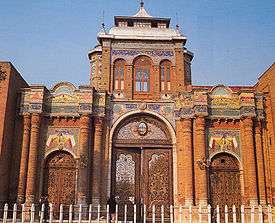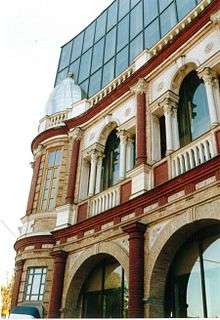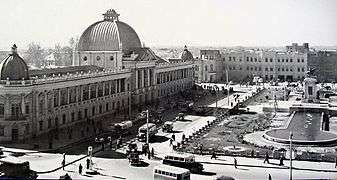Architecture of Tehran
.jpg)



Tehran has grown dramatically since Mohammad Khan Qajar chose it as the capital of the Qajar dynasty in 1796. Despite the occurrence of earthquakes during the Qajar period and before, some buildings still remain from Tehran's era of antiquity. However, most of Tehran's historic architecture has been obliterated by the wave of hasty modernization that swept through the capital over the last 40 to 50 years. Of the eight city gates of old Tehran, none remain today.
The Qajar culture flowered into a mature form of vernacular architecture, and many relics today remain of this tradition. Most, however, are government offices and residences of the royal elite. The "Kushak" of Ahmad Shah in the Niavaran Palace Complex is a fine example of this tradition.
Many of the urban designs of modern Tehran are attributed to Victor Gruen. Gruen devised a master plan for many of northern Tehran's neighborhoods between the years 1963-1967.[1][2][3][4] Many palaces were built and by the late 1970s. Tehran had grown so large that Ray, a former satellite and city in itself, became connected to the ever expanding "Greater Tehran".
Pahlavi architecture tried incorporated themes from European Modern architecture. The "White House" of Sadabad Palace and the main Palace of Niavaran are examples of this style of design.
Features of the city include gates and palaces. Despite the chaotic sprawl of Tehran, many designers are gradually incorporating aesthetics in their designs, and international awards have been given to projects in the city.[5][6]
The architectural development of Tehran according to Richard Frye
Prominent Iranologist Richard Nelson Frye launched the May 2004 Tehran architecture conference[7] with a candid critique of Tehran's architectural development. He stated that municipal authorities have turned their backs on Tehran's heritage and looked toward the West - Paris, London and New York — for inspiration. "I think they abandoned Tehran", he is quoted as saying, "Innovation, yes. But not slavish copying. Forgetting your heritage, forgetting your background is not recommended."
Frye continued that modern buildings in Tehran should maintain a Persian style and sensibility and "not be a copy of the bad architecture that sweeps the world in globalization", he remarked. "I think it’s essential that the heritage of a people be preserved. If Wal Mart came to Isfahan, what would happen to the bazaar?"
Frye has urged Iranians to work hard to preserve their identity.[8]
Gallery
-

Details of the gates of Bagh e Melli reveal a wealth of craftsmanship during the Qajar era.
-

Toopkhaneh Square, like many other architectural gems and historic buildings in Tehran was destroyed during the city's modernization programs
-

Modern architecture in Tehran.
See also
- Architecture of Iran
- List of tallest buildings in Tehran
- Goldis Tower
- Tehran International Tower
- Bāgh-e Ferdows
References
- ↑ Encyclopædia Britannica entry for Victor Gruen:
- ↑ Mall Maker: Victor Gruen, Architect of an American Dream. M. Jeffrey Hardwick, Victor Gruen. University of Pennsylvania Press, 2004. ISBN 0-8122-3762-5 pp.220
- ↑ http://memory.loc.gov/service/mss/eadxmlmss/eadpdfmss/uploaded_pdf/ead_pdf_batch_27_December_2004/2001/ms001017.pdf
- ↑ "Archived copy". Archived from the original on 14 January 2009. Retrieved 2009-01-12.
- ↑ "Archived copy". Archived from the original on 29 May 2006. Retrieved 2006-04-22.
- ↑ "Archived copy". Archived from the original on 5 May 2006. Retrieved 2006-04-22.
- ↑ "Archived copy". Archived from the original on 4 November 2005. Retrieved 2006-04-22.
- ↑ http://www.loc.gov/loc/lcib/0408/iran.html
External links
- Architecture of Tehran at the archINFORM database.
- Library of Congress on Tehran's Architectural Conference
- US State Dept on the Conference
- On the Shahyad (Azadi) Tower
- Photos from the changing face of Tehran
- Modernized Iranian architecture in Tehran (Video, 6 min 48 sec), Press TV, 26 September 2010.
- Tehranimages. Contemporary photos taken in some of the oldest districts of Tehran.


